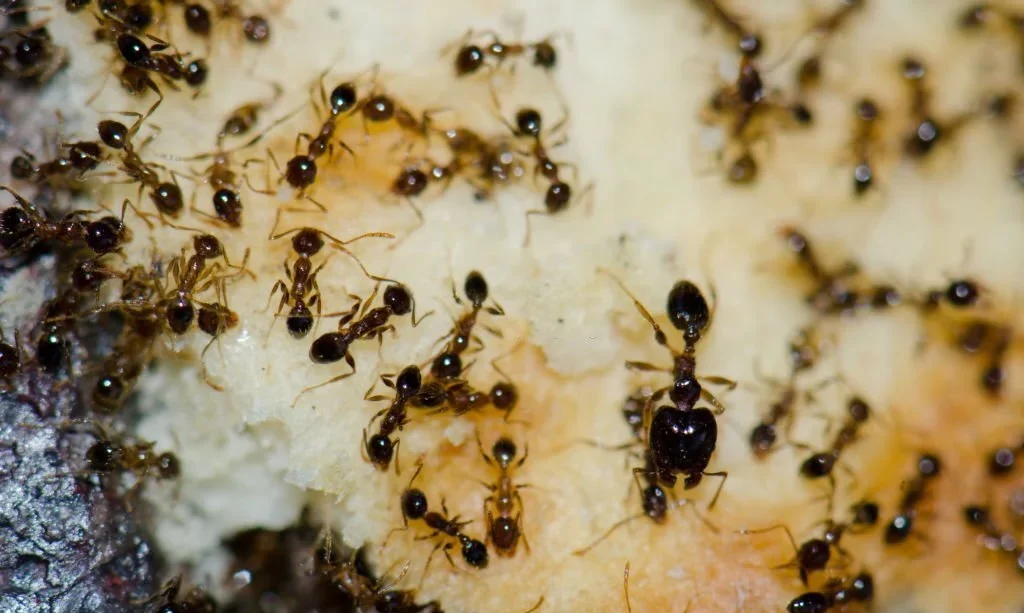Argentine ants, with their unrelenting presence and propensity to form massive colonies, can quickly disrupt the tranquility of homes and gardens. If you’re grappling with an Argentine ant infestation, it’s imperative to take swift and effective action. In this guide, we will provide you with a systematic approach to rid your space of Argentine ants and prevent their unwelcome return.
- Attracts and kills all common household ants
- Includes 12 pre-filled, ready-to-use bait stations
- Easy activation – push down and twist the bait cup
- Works fast – reduces population in days
- Ready to use – place the bait, attract ants, eliminate the colony
Identify Argentine Ants
To effectively combat an Argentine ant infestation, it is essential to be certain that these are the pests you’re dealing with. Here’s how to identify Argentine ants:
- Size and Color: Argentine ants are relatively small, measuring between 1/16 to 1/4 inch (1.5 to 6.4 mm) in length. They typically exhibit a uniform dark brown to black coloration.
- Foraging Trails: Argentine ants are known for establishing distinct foraging trails as they search for food. These well-defined trails often lead back to their nest.
- Preference for Sweets: These ants have a strong attraction to sugary foods and can frequently be found near food sources.
Before launching into ant control measures, it’s crucial to be certain that you are indeed dealing with Argentine ants. Accurate identification ensures that your efforts are directed at the right target and increases the likelihood of successful eradication.
Locate and Destroy the Nest
The Argentine ant nest is the heart of the problem, and eradicating it is essential for effective control:
- Track Ant Trails: Carefully follow the visible ant trails, which can lead you to the nest’s location. These trails often converge at entry points or food sources.
- Nest Identification: Argentine ant nests are typically situated in concealed or damp areas, such as beneath rocks, logs, or near water sources. Keep an eye out for soil excavations or ant activity in these areas.
- Use Ant Bait: Employ ant bait stations near the entrance of the nest. Argentine ants are known to feed on bait and share it with the colony, which can lead to the eradication of the entire nest.
Maintain Cleanliness
Preventing future Argentine ant infestations relies on keeping your surroundings clean and unattractive to these pests:
- Thorough Cleaning: Regularly clean countertops, floors, and food preparation areas to eliminate food crumbs and spills that attract Argentine ants.
- Food Storage: Store food in airtight containers to prevent ants from accessing it. Ensure that pet food is also securely stored.
- Outdoor Cleanup: Maintain cleanliness in outdoor spaces, removing potential ant food sources such as fallen fruit, spilled birdseed, and garbage. Ensure trash cans have secure lids.
By implementing these cleanliness practices, you not only remove current ant attractions but also create an environment less inviting to Argentine ants, reducing the likelihood of future infestations.
Create Physical Barriers
Establishing physical barriers can help deter Argentine ants from entering your living spaces:
- Seal Entry Points: Inspect your home’s foundation, walls, doors, and windows for cracks, gaps, or crevices that ants could use to gain entry. Seal these openings using caulk or weatherstripping to block their access.
- Utilize Ant Traps: Place ant traps or barriers at key entry points, such as doors, windowsills, and along ant trails. These traps can intercept and capture ants trying to infiltrate your home.
Consider Professional Help
If the Argentine ant infestation proves persistent or extensive, it may be prudent to seek the assistance of professional pest control services:
- Expertise and Tools: Pest control experts possess the knowledge, experience, and specialized tools needed to effectively eliminate large ant colonies and provide long-term solutions.
- Safe Pest Control: Professionals can apply pest control methods safely, minimizing potential risks to your health, pets, and the environment.
- Customized Solutions: Pest control services can tailor their approach to your specific situation, ensuring the most effective treatment for your Argentine ant problem.
Conclusion
Argentine ants may be relentless, but with a well-structured plan and determination, you can successfully rid your living spaces of these persistent pests. By accurately identifying Argentine ants, locating and destroying their nests, maintaining cleanliness, creating physical barriers, and enlisting professional help when necessary, you can regain control over your home and garden.
Remember that diligence and consistency are essential in maintaining Argentine ant control. With your proactive efforts and the strategies outlined in this guide, you can ensure a pest-free environment and enjoy the peace and comfort of your home once again.




